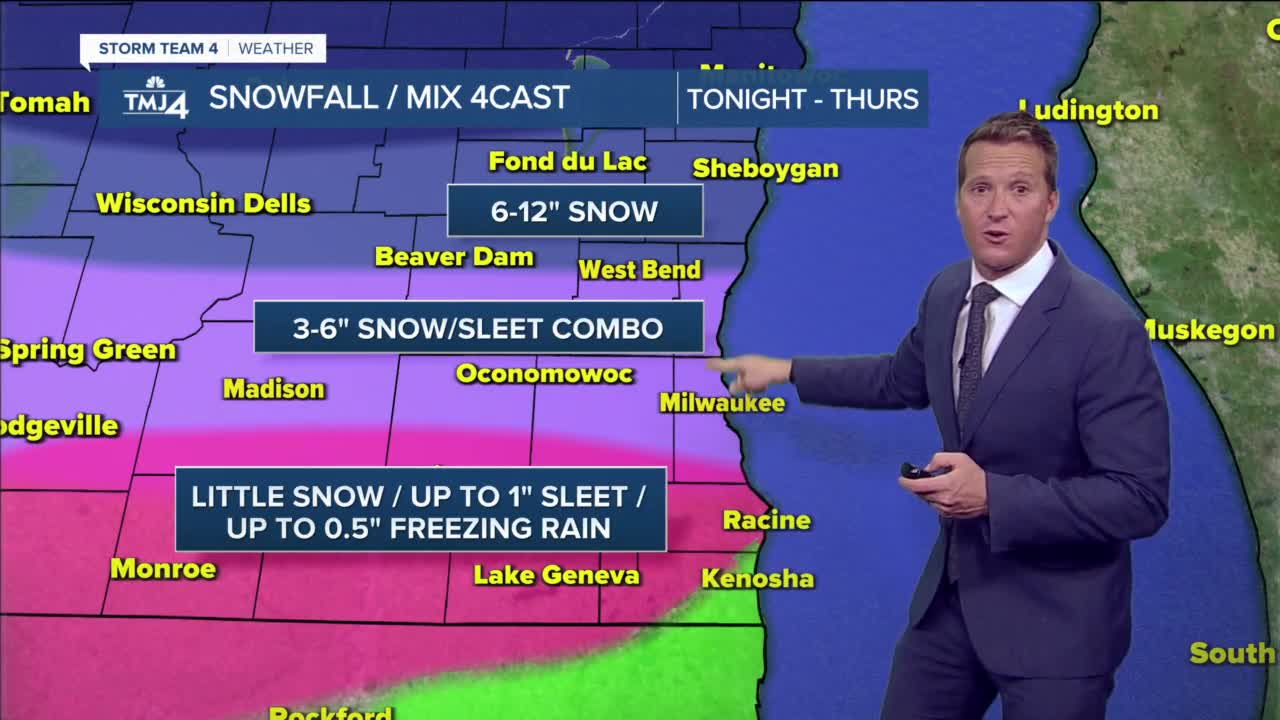MILWAUKEE — A Winter Storm Warning has been issued for most of Southeast Wisconsin and the Milwaukee Health Department wants to make sure residents are prepared to stay safe and warm.
Here in Milwaukee, the National Weather Service issued a Winter Storm Warning beginning at 9 a.m. on Wednesday and ending at 12 p.m. Thursday.
Snow moves in beginning Tuesday night and will continue through early Wednesday. Most of southeastern Wisconsin will pick up less than 1". Snow, sleet, freezing rain, and rain will move into the area after 12 p.m. Wednesday. The heaviest precipitation will be Wednesday night with light snow and sleet showers continuing through midday Thursday. Widespread ice accumulation of around 1/2" is possible and could cause dangerous driving conditions and potentially snap tree branches, leading to power outages.
Snow totals are expected to change as the storm approaches. The storm will also bring gusty winds with gusts near 45 mph.
In preparation for significant travel impacts and potential power outages, the Milwaukee Health Department has provided the following tips:
- Prepare an emergency kit for your home and your car that includes:
- Candles and matches
- Hand-cranked or battery-operated flashlight and radio
- Fully-charged cellular phone
- Extra batteries and external chargers
- Blankets or sleeping bags
- Extra clothing
- High-calorie non-perishable food
- Extra food and water for pets
- First aid kits and any medications you require
- Tool kit
- Ensure your vehicle’s fuel tank is at least half full and the battery is fully charged.
- Charge all portable devices, cell phones, external chargers, and lanterns or flashlights ahead of time.
- Heat your home with devices approved for indoor use, and ensure they are properly vented to prevent carbon monoxide poisoning or fires.
- Never use wood-burning or coal-burning grills, camp stoves, or other outdoor devices indoors.
- Remember to keep flammable materials such as paper, blankets, or clothing away from portable heaters.
- Avoid traveling, especially during periods of extreme snow or ice, unless in the case of an emergency.
- Adjust your driving by slowing down and providing more space for braking.
- Check on your neighbors, especially those who are elderly or with high-risk medical conditions, to ensure they have heat and ample supplies.
- Dress warmly in water-resistant layers with gloves, hats, and scarves when outdoors.
- Sand or salt icy sidewalks or walkways and take care where you step to avoid slips and falls.
- Check local news and weather reports [weather.gov] for extreme cold weather alerts and safety tips.
- Be aware of symptoms of cold weather-related illness:
- Hypothermia: includes shivering, drowsiness, clumsiness, and confusion. Usually caused by extreme cold, but can occur at temperatures above freezing if an individual becomes wet and chilled from precipitation.
- Frostbite: includes numbness, tingling, stinging, and aching
- Carbon Monoxide Poisoning: includes headaches, nausea, disorientation, seizures, coma, respiratory failure, and death.
Further winter weather safety can be found on the city's website.
The Wisconsin Department of Transportation (WisDOT) is warning drivers to plan ahead and visit 511wi.gov to monitor road conditions and view live videos from traffic cameras.
Snowplow crews and emergency responders across the state are prepared for potentially hazardous conditions throughout the duration of the storm, WisDOT said.
WisDOT also provided the following tips for travelers:
Before traveling
- Check 511wi.govfor road conditions or incidents along your route.
- Clear snow and ice from vehicles before traveling.
- Fill the gas tank and windshield washer fluid.
- Have a fully charged phone and an emergency kit in your vehicle.
- Alert others about your route and expected travel time.
While traveling
- Snow means slow. Allow extra travel time, following distance, and reduce your speed during winter conditions.
- Be cautious on bridges, overpasses, and entrance and exit ramps.
- Don’t be overconfident in four-wheel or all-wheel-drive vehicles. All vehicles require additional time and distance to stop in adverse conditions.
- Avoid using cruise control in winter conditions.
- Buckle up and put your phone down while driving. Every trip, every time.
- Leave room for maintenance vehicles and snowplows. Move over or slow down for stopped emergency vehicles.
- Stay at least 200 feet behind a working snowplow. Make sure that you can see the plow’s mirrors to ensure the driver can see you.
- In case of a crash or slide off, stay in the vehicle, turn on the hazards, call 911 and move vehicle(s) out of traffic if possible.
Tips for motor carriers
- Trucking companies and their drivers should review their schedules and routes and plan accordingly.
- Commercial motor vehicle drivers are encouraged to check 511wi.gov before leaving and throughout their trips.
- Oversize/overweight vehicle drivers are reminded their permits restrict operations during inclement weather.
Portable generator safety:
- Never use a generator indoors. Use it in a dry area outdoors and away from open doors, windows, and vents.
- If you must use extension cords, make sure they are grounded with three prongs. Coiled cords can get extremely hot; always uncoil cords and lay them flat.
Gasoline and its vapors are extremely flammable. Let the generator engine cool at least two minutes before refueling. Always use fresh gasoline.





